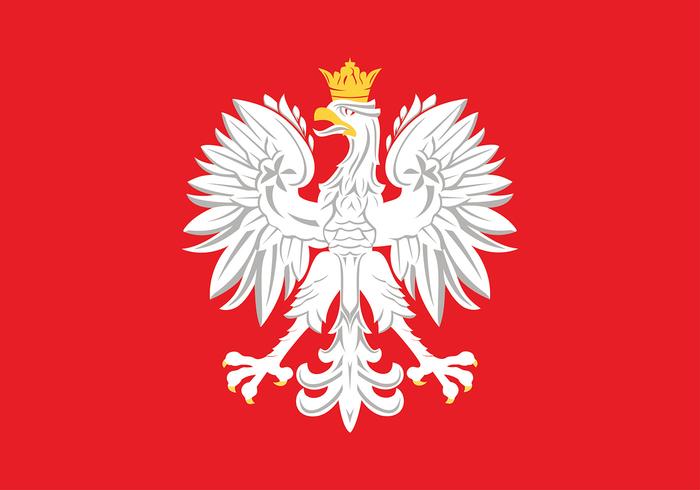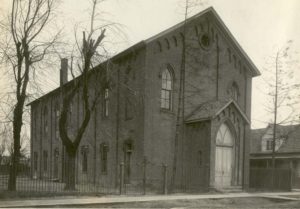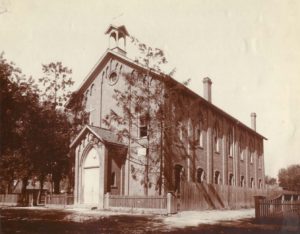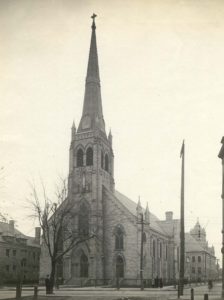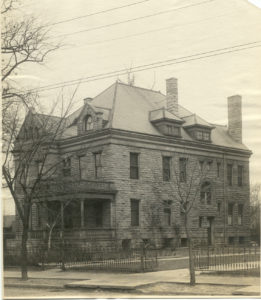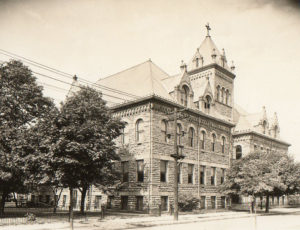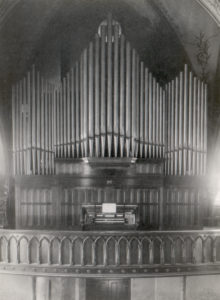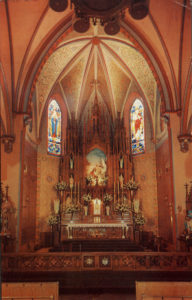St. Hedwigs
Toledo Polish Churches > St Hedwig Church
St. Hedwig Parish: the First Polish Catholic Church in Toledo, Ohio
Beginning in 1867, Polish immigration to Toledo saw these earliest settlers living in north Toledo just east of St. Vincent Hospital, along Frederick Street. Being from the German-occupied area of Poland, they were familiar with the German language and chose to attend St. Mary’s German parish, at that time located at Cherry and Michigan streets. By 1875, there were several hundred Poles in Toledo.
Father Vincent Lewandowski, the first pastor, arrived in October 1874. The first Mass of the Polish parish was celebrated in St. Mary church basement on October 16, 1875, St. Hedwig’s feastday. Fr. Lewandowski purchased nine lots on Dexter and Bronson streets near Warsaw, later the site of Dexter Park, now called Polonia Park. The red brick church fronting on Dexter Street was 33 feet by 83 feet and was blessed on May 7, 1876. The church was dedicated on October 22, 1876 with much fanfare.
Early on, the area was known as the Polish Settlement (in the 1880 census), and later called Lagrinka, a Polonized version of the main thoroughfare running through the area, Lagrange Street. Lagrange was named after the French estate of the Marquis de Lafayette, a hero of the American Revolution who died in 1834, about the same time the city of Toledo was formed.
In early 1873, Poles also began to settle in the western portion of the German Lenks Hill area, just west of downtown Toledo. These Poles attended services and sacraments at St. Peter Church (later called Saints Peter and Paul) German parish, on St. Clair Street near Harrison, south of Swan Creek. When St. Hedwig parish began functioning, most of these Kuhschwanz Poles went to St. Hedwig’s. In 1882, Father Lewandowski helped to found St. Anthony parish on Nebraska Avenue and was its’ first pastor as well as pastor of St. Hedwig.
Jacob Rozan was the first teacher and organist. Soon after, the Felician Sisters from Livonia, Michigan began teaching school. The “Polish Riot” occurred in June 1885, which led to Fr. Lewandowski’s departure. In February 1886, a fire destroyed the interior of the church. After being rebuilt, the church was rededicated on June 27, 1886, the same day that Reverend Simon Wieczorek took over as the new pastor.
The Franciscan Sisters of Rochester, Minnesota sent several nuns to the school in 1887, and they remained until the founding of the Sisters of St. Francis of Sylvania, Ohio in 1917. The old St. Hedwig church building served as the Provincial House of the Sylvania Franciscans from 1914 to 1918. The Franciscan Sisters continued to serve St. Hedwig school until its closing in 2005.
Bishop Richard Gilmour of the Cleveland Diocese bought the entire block of land bounded by Lagrange and Elm streets and Dexter and Bronson Avenue in 1890. Part of the land was used for church property, and the larger eastern portion was divided into lots and sold to residents after the dedication of the church. It was called Wieczorek’s Addition.
There were almost 2,000 parishioners by the time construction of a new church building began in early 1891. This Sandusky bluestone Polish Gothic church measures 160 feet in length, and 75 feet wide at the transept, and sat 1,265 people. It is located on the parish grounds at 2916 Lagrange Street, between Dexter and Bronson streets. The formal dedication was held on April 23, 1893. A stone pastoral residence was built in 1901, and two years later the school building was constructed behind the church. The school had two floors of classrooms, an auditorium on the third floor, and a full basement with club rooms, restrooms, kitchen, two rooms dedicated to kindegarten, a boiler room and storage.
An increasing number of Polish immigrants demanded the opening of a new Polish parish in Lagrinka in 1907. A site was chosen just five blocks north of St. Hedwig, with residents north of Park Street required to register at the newly-created St. Adalbert parish. In 1920, 10,283 residents of Toledo were born in Poland, making Poles the largest ethnic group at that time. Out of the 22,000 residents of the fourth ward (Lagrinka), over 23% were Polish. Of the 13,900 residents of the fourteenth ward (Kuhschwanz), 22.8% were Polish.
The old St. Hedwig church-school building (at Dexter Park) had many uses after the new church was built: as a meeting place for organizations and the location of the first Masses held by St. Adalbert parish as well as that parish’s first school, a convent for the parish nuns, as well as storage.
A belfry was constructed in 1881 adjacent to the old church-school building on Dexter Street. In an elaborate ceremony in September that year, the bells were named after two saints, blessed like in a baptism and the saints’ and godparents’ names were inscribed on each bell. The larger bell is named for St. Francis of Assisi, and the smaller for St. Anthony of Padua. The bells were moved to the new church building after its construction, and rung by hand with ropes in the vestibule, until switching to an electric method in the 1940s.
Other items from the old church building that were brought to the new one, and still on display, include a cast-iron life-size statue of Mary (found on the Mary side altar), the large Mission Crucifix, the St. Joseph statue with the child Jesus (on the St. Joseph side altar), and a smaller wooden statue of the Blessed Virgin Mary (which also survived the fire of 1886). The large side altar of the BVM was said to have been the main altar of the old church and contains a tabernacle, and the two smaller altars (which held the smaller BVM and Sacred Heart statues) were the old church’s side altars. Two statues of angels now displayed on the steps of the main altar are said to have been from the old church.
The church building has been rennovated and redecorated several times, including 1953, 1980 and the 1990s, and was recently repainted and recarpeted. The second set of stained glass windows was installed in 1961-62, after wind damage to the originals. The Sanctuary windows depicting the Sacred Heart of Jesus and the Immaculate Heart of Mary were installed in 1958-59.The only original stained glass windows are located on the front of the church, to the left and right of the ten-foot-tall white marble statue of St. Hedwig, which was placed in its niche in 1904.
Pew rental was once required to seat one’s family for Sunday High Mass, with name tags mounted on the back sides of the pews facing the renters, above the kneelers. Rental was once $ 12.00 per year, with each parishioner’s pew rent book marking payments. Pew rental also served to prove parish membership, for purposes such as school tuition.
The large organ was dedicated during a musical program in 1906, and had been in use for over 100 years until it could no longer be repaired; a new modern organ was purchased in 2010. The new altar of sacrifice, facing the people, was constructed and first used in 1967. The communion railing was removed in 1970. The church has an attic and full basement. Parishioners contributed to the parish preservation society and several of the stained glass windows were restored. The Knights of Columbus donated the stone carving of the Ten Commandments, placed outdoors near the cornerstone.
St. Hedwig parish celebrated its centennial anniversary in 1975 with a dinner for parishioners, a dinner dance, and the publication of an anniversary book. The 288-page soft-cover book contains over 400 photographs, history of Poland, history of the Toledo area as well as the parish, neighborhood, and early Polish-Americans in Toledo. The current church building celebrated its 100th anniversary in 1991 with many activities, and the 125th anniversary was remembered with a dinner at the Franciscan Convent grounds in Sylvania.
St. Hedwig School was wired for high-speed internet, had a radio/TV station, served hot lunches to its students and cooked and sent hot lunches to Rosary Cathedral School. In 2005, St. Hedwig School closed and was merged with St. Adalbert school, becoming John Paul II School and located in the St. Adalbert school building. John Paul II School closed in June 2008. The St. Adalbert school building is currently being used by a charter school.
Father George Rinkowski was instrumental in acquiring the former Ohio Theatre at 3114 Lagrange Street near Central Avenue in 1974. It was used for school functions, movies and concerts, and rental activities. The Historic Ohio Theatre is the home of the Toledo Area Theatre Organ Society. Originally containing 1800 seats, it now has 964, and is on the National Register of Historic Places. St. Hedwig Parish (Toledo Diocese) sold the theatre in 2004 to the Ohio Theatre, Inc. (a non-profit management board). In 2009 it was purchased by United North (formerly the Lagrange Development Corp.).
St. Hedwig parish was twinned with St. Adalbert parish in 2005, and both were supressed (diocesan term for disbanding or closing, all employees and organizations were terminated, and both parish’s record books were sent to the diocesan archives) in 2010, ending separate parish records. In 2010, the new Saints Adalbert and Hedwig parish was formed (now called “merged” by the diocese), and a new set of records was started; this new parish was also paired with St. Joseph in downtown Toledo. As of September 1, 2012, the St. Hedwig Church building was closed and given oratory status. No Masses are available there, except for weddings and funerals by special arrangement.
The last Sunday Mass was celebrated by Pastor Joseph Poggemeyer, and the Reverends Paul Kwiatkowski (former pastor) and Thomas Mulanjanani (associate pastor, leaving the parish after this Mass) and Deacon Gerald Ignatowski with nine altar servers. Father Paul gave an inspirational sermon and brought his copy of the St. Hedwig 100th anniversary book to the pulpit. Organist Shirley Czyzewski and St. Hedwig choir members, along with singers from St. Adalbert and other parish choirs, provided the music. 356 people attended the 11:00 a.m. Mass on August 26, 2012, and 150 attended the potluck dinner afterward in the St. Hedwig school club rooms. TV channels 11 and 24 taped portions of the Mass and interviewed parishioners; these two videos can be seen on the internet (www.toledonewsnow.com and www.northwestohio.com).
| St. Hedwig first church built 1875
The first St. Hedwig Church building was built in 1875 and located on the north side of the 100 block of Dexter Street, just to the east of Warsaw Street (then called Locust Street). It was made of red brick and measured 33 feet by 83 feet, with a 2-room school on the lower floor and the church on the second floor. It was used as a church from its construction in 1875 until the new church was completed and dedicated in April 1893. |
| St. Hedwig first church in 1917
The first St. Hedwig Church was used as a church and school until 1893, when the new church building on Lagrange Street was ready for use. Then the old building, pictured here in 1917, was converted to a school, making four classrooms out of the old church floor, in addition to the two classrooms on the first floor. It was used as a school and storage for many years, in addition to serving as the first meeting place for St. Adalbert parish services while its church building was being constructed in 1907. |
| St. Hedwig church
Construction of the St. Hedwig Church on Lagrange Street, between Dexter Street and Bronson Avenue, was begun in the spring of 1891 and completed in October 1892. The church was built of Sandusky bluestone in the Polish Gothic style. Variously colored slate tiles were layed in patterns on the roof and bore the years “1891” and “1892.” This photograph dates from about 1910. Note the unpaved dirt street (Dexter Street) at the bottom of the picture, and the fire hydrant to the left and the water well pump to the righ |
| St. Hedwig rectory
The St. Hedwig rectory stands next to the church, at 2916 Lagrange Street, on the east side of Lagrange between Dexter and Bronson. It was built in the spring of 1901. Construction of the second church building, at this location on Lagrange Street, was begun in 1891. |
| St. Hedwig school
St. Hedwig School was built behind the second St. Hedwig Church building on Lagrange Street, on the north side of Dexter Street, in 1903. Enrollment in the school that year was over 1,000 students. Just to the right of the church, one can see the old house used as the convent until 1922. |
St. Hedwig convent old building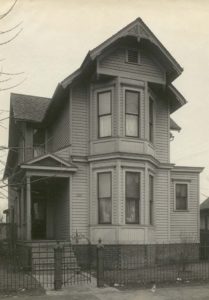
This house, at 301 Dexter Street, stood next to St. Hedwig School and was used as the St. Hedwig Convent by the Franciscan Sisters until it was dismantled in 1922 and moved across the street to 222 Dexter Street. A new convent was built in 1922 just behind this one, at 252 Bronson Avenue. |
|
Organ
This organ was dedicted in 1906 and served the congregation for over 100 years. |
| St. Hedwig interior about 1960
Interior of the church, built in 1890’s. This view from the late 1950’s to 1960. |
St. Hedwig church about 1930
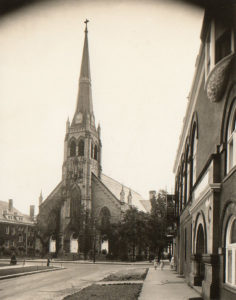
| St. Hedwig rectory, about 1930 |
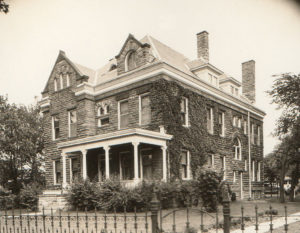
| St. Hedwig convent, built in 1922, about 1930 |
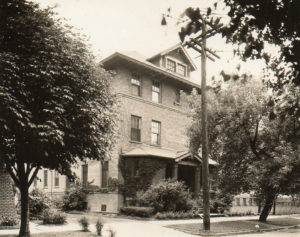 |
Sacramental record books (aka metrical books) exist from 1875 to the present for baptisms and marriages. The death records begin in February 1886, right after the fire in the church. The first book of deaths was probably destroyed by the fire. The earliest records can be seen online at the LDS database and website (www.familysearch.org), though they must be accessed by searching for Ohio – Diocese of Toledo records, then by parish; they are not on the LDS online index. The actual record books are stored at the diocesan archives in downtown Toledo. Contact the archives to obtain or view these records.
Pastors of St. Hedwig Parish:
Reverend Vincent Lewandowski (1874-1885)
Reverend Simon J. Wieczorek (1886-1901)
Reverend Francis F. Doppke (1901-1907)
Monsignor Benedict Rosinski (1907-1933)
Reverend Anthony S. Pietrykowski (1933-1968)
Reverend George M. Rinkowski (1968-1984)
Reverend Paul M. Kwiatkowski (1984-1994)
Reverend Joseph J. Przybysz (1994-2005)
Reverend Marek Ciesla (2005-2008)
Reverend Richard Philiposki (2008-2010)
Reverend Joseph Poggemeyer (2010-2012)
Sylvania Franciscan Sisters Who Served as Principals of St. Hedwig School:
Sr. M. Salome (1916-1918)
Sr. M. Leocadia (1918-1932)
Sr. M. Chrysantha (1932-1938)
Sr. M. Bronislas (1938-1939)
Sr. M. Chrysantha (1939-1942)
Sr. M. Bronislas (1942-1948)
Sr. M. Ernestine (1948-1953)
Sr. M. Francis Regis (1953-1959)
Sr. M. Loretto (1959-1960)
Sr. M. Francis Regis (1960-1966)
Sr. M. Theodora (1966-1974)
Sr. M. Mercedes (1974-1976)
Sr. M. Myra (1976-1982)
Sr. M. Charlotte (1982-1988)
Sr. M. Valerie Grondin (1988-2005)
For a complete list of the Sylvania Franciscan sisters who served St. Hedwig parish up to 1974, as well as the names of the Rochester Minnesota sisters who taught at St. Hedwig from 1886 to June 1917, see the parish centennial anniversary book.
First Baptisms:
Martin Golembiewski, son of John and Anna (Brykacz) Golembiewski, born Oct. 18, 1875
Cecilia Stelmaszak, daughter of Joseph and Rose (Stoinska/Stoiszka) Stelmaszek (originally Stelmaszewski), born Oct. 8, 1875
Both were baptized on Oct. 24, 1875 by Fr. Vincent Lewandowski
First Marriages:
John Czerniejewski and Anna Maciejewska, witnesses Jacob Stelmaszewski and Adalbert Maciejewski
Married on Nov. 21, 1875 by Fr. Vincent Lewandowski
John Czaja and Frances Pryba, witnesses Melchior Szwajkowski and Michael Bialecki
Married on Nov. 24, 1875 by Fr. Vincent Lewandowski
Patron Saint:
St. Hedwig, Jadwiga (in Polish), Duchess of Silesia, 1174-1243, feast day October 16
Jadwiga was the daughter of Count Berthold IV of Andechs, Bavaria, and his second wife Agnes of Wettin; she was born at Andechs Castle. Hedwig was the aunt of St. Elizabeth of Hungary. When she was 12, she was married to Duke Henry of Silesia. In 1202, Henry succeeded to the dukedom and Hedwig requested that he build a Cistercian monastery for nuns at Trzebnica, the first of its kind in Silesia. They also founded many other monasteries and hospitals. They had seven children. After Henry’s death in 1238, Hedwig moved into the monastery in Trzebnica, where she died on October 15, 1243. She was canonized in 1267, and is the patroness of Silesia, brides, widows and orphaned children.
Prayer:
All powerful God, may the prayers of St. Hedwig bring us your help and may her life of remarkable humility be an example to us all. We ask this through our Lord Jesus Christ, Your Son who lives and reigns with you and the Holy Spirit, One God, forever and ever. Amen
Address:
2916 Lagrange St.
Toledo, Ohio 43608
Bibliography:
The First Hundred Years: 1875-1975, A History of St. Hedwig Parish, Toledo, Ohio, by the St. Hedwig Centennial Anniversary Committee (Rosemary Dembinski Chorzempa, chairman; Dr. David G. Chelminski, Larry Chorzempa, Mark D. Dembinski, Gerald A. Mazuchowski, Michael J. Niemiec, Melvin R. Ogrodowski), 1975, printed by the Gray Printing Co., Fostoria, Ohio.
Dictionary of Saints by John J. Delaney, Doubleday & Co., Inc., Garden City, NY, 1980.
Clerus Toletanus: A Directory of Clergy, Religious Communities and Parishes of the Diocese of Toledo in America, 1910 to 2011, vol. 1 no. 1
